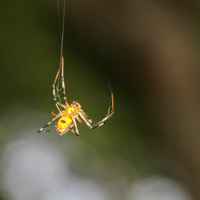Login
Subscribecoloration

Black and Gray Wolf Pairings Stem Disease, Stabilize Population: Study
Katherine Irving | Oct 20, 2022 | 4 min read
The black fur allele has fitness costs but also confers higher immunity against canine distemper virus, making mix-and-match mating key to population survival.

Genome Spotlight: Mandarinfish (Synchiropus splendidus)
Christie Wilcox, PhD | Oct 28, 2021 | 3 min read
The high-quality genome sequence sheds light on the colorful nature of these popular aquarium fish.

My Daughter’s First Pet—the Next Big Model Organism?
Christie Wilcox, PhD | Jul 15, 2021 | 10+ min read
Bettas were likely the first fish welcomed into human homes. Now, scientists are welcoming them into the lab to learn how genes dictate their appearance and behavior.

Editor’s Picks of The Scientist’s Best Infographics of 2020
Jef Akst | Dec 15, 2020 | 2 min read
This year’s most captivating illustrations tell stories from the micro scale—such as newborn neurons in the adult brain and bacteria in the infant gut—to the scale of entire ecosystems, including reintroduced predators and rising seas.

Infographic: Dialing Down the Glitz
Rachael Moeller Gorman | Sep 1, 2020 | 1 min read
The gene BCO2 enables male and female members of some bird species to display dramatically different color patterns.

The Gene that Makes Female Birds Drab
Rachael Moeller Gorman | Sep 1, 2020 | 3 min read
In some finch species, the difference between colorful males and muted females comes down to one gene, BCO2, which encodes an enzyme that degrades carotenoids.

Spider’s Orange Colors Both Lure Prey and Frighten Predators
Jake Buehler | Apr 22, 2019 | 3 min read
Spotted coin spider colors are a Swiss army knife of deception, bringing food closer, and keeping assailants at bay.

Image of the Day: Squid Skin
Carolyn Wilke | Mar 13, 2019 | 1 min read
The cephalopods use several strategies to manipulate light and produce their colorful patterns.

Hawaiian Spiders on Different Islands Evolved Same Disguise in Parallel
Catherine Offord | Mar 8, 2018 | 2 min read
In an unusual evolutionary twist, local stick spiders have come up with an almost identical repertoire of color morphs in multiple locations.

Image of the Day: Living Color
The Scientist Staff and The Scientist Staff | Mar 8, 2018 | 1 min read
Biodegradable pigments could be custom-grown by bacteria in the future, say researchers.

Image of the Day: Rainbow Butt
The Scientist Staff and The Scientist Staff | Jan 4, 2018 | 1 min read
Scientists explore why male peacock spiders are so colorful.

Behavior Brief
Catherine Offord | Jun 13, 2016 | 5 min read
A round-up of recent discoveries in behavior research

Butterfly Eyespots Deflect Predation
Bob Grant | Nov 12, 2014 | 2 min read
Researchers show that patterned coloration can be an effective means of distracting predators from vital body parts.
